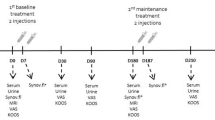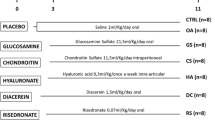Summary.
Osteoarthritis (OA) influences the levels of free intraarticular glucosaminoglycans (GAG). Little is known about the direction – decrease/increase – of these changes, and information on the correlation between GAG levels and the degree of OA is sparse. Objectives of this study were to investigate the correlation between intraarticular levels of sulphated and unsulphated GAG and the degree of experimental OA, the time course of these changes and whether GAG might be useful as a marker for OA. Twenty-one sheep were randomly assigned to three groups: (1) transsection of the posterolateral bundle of the anterior cruciate ligament, ACL (TD), (2) medial meniscectomy (ME), and (3) meniscectomy and resection of the ACL (MV). During follow-up clinical and radiological examinations were done. After screening for intraarticular effusions, a joint tab was performed and the levels of hyaluronic acid and chondroitin sulphate were measured. The radiological scores differ significantly between group TD and groups ME and MV (P < 0.01). Hyaluronic acid levels in ME and MV are significantly higher than in the controls. Significantly increased levels (P < 0.01) of chondroitin sulphate are found 6 months after ME and 1 year following TD. Clinical consequences: Hyaluronic acid levels – at least in the experimental setting – correspond to a certain degree with osteoarthrotic changes: increasing levels were found along with increasing postoperative interval and increasing grade of OA. Chondroitin sulphate, on the other hand seems, to lend itself as a marker for chondromalacia, in other words for prearthrotic deformities and early stages of OA.
Zusammenfassung.
Bei arthrotischen Erkrankungen der Gelenke kommt es zu Verschiebungen der Konzentration von freien intraarticulären Glykosaminoglykanen (GAG). In dieser Untersuchung am Schaf sollte geklärt werden, ob die intraarticuläre Konzentration freier sulfatierter und nicht sulfatierter Glykosaminoglykane eine Korrelation zum Ausmaß experimentell induzierter arthrotischer Schäden zeigt, ob sich eine zeitliche Zuordnung ergibt und ob sich anhand der Ergebnisse ein Anhalt für den Einsatz der GAG als prognostisches Kriterium bzw. Arthrosemarker annehmen läßt. 21 Schafe werden randomisiert in 3 Gruppen à 7 Tiere unterteilt: Durchtrennung des posterolateralen Anteils des vorderen Kreuzbandes (VKB) (TD), Meniscektomie (ME), Meniscektomie und Resektion des VKB (MV). Über den Zeitraum von 48–53 Wochen erfolgen klinische, radiologische und sonographische Verlaufskontrollen und die Probenentnahme der Gelenkflüssigkeit zur Messung von Hyaluronsäure (HA) und Chondroitinsulfat (CS). Als Kontrollen dienen die Kniegelenke der kontralateralen Seite und Kniegelenke von Tieren aus anderen genehmigten Projekten (n = 54). Die radiologischen Scorewerte zwischen den Gruppen TD vs. ME und MV sind statistisch signifikant (p < 0,01) verschieden. Gegenüber der Kontrollgruppe zeigt sich bei der HA in den Gruppen ME und MV ein signifikant erhöhter Wert. Beim CS ergibt sich sowohl für die Messung 6 Monate postoperativ in Gruppe ME sowie ein Jahr nach Teildurchtrennung ein signifikant erhöhter Spiegel (p < 0,01). Klinische Konsequenzen: Der HA-Spiegel erlaubt – zumindest experimentell – möglich, in gewissem Umfang eine Beschreibung des Arthrosegrads. Die Konzentration nimmt mit größerem postoperativen Intervall und steigendem Schädigungsgrad zu. Im Gegensatz dazu scheint das CS als Marker für einen Knorpelschaden mithin für präarthrotische Veränderungen zu dienen.
Similar content being viewed by others
Author information
Authors and Affiliations
Rights and permissions
About this article
Cite this article
Scherer, M., Metak, G., Haas, B. et al. Glykosaminoglykane als Marker für die posttraumatische Gonarthrose?. Chirurg 69, 82–90 (1998). https://doi.org/10.1007/s001040050379
Issue Date:
DOI: https://doi.org/10.1007/s001040050379




